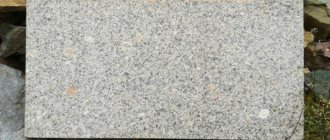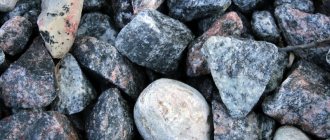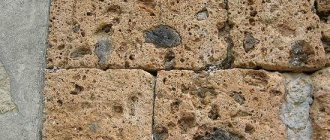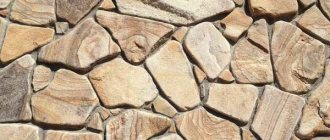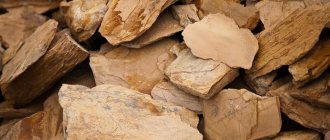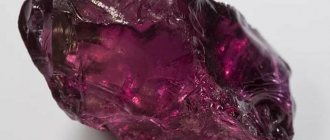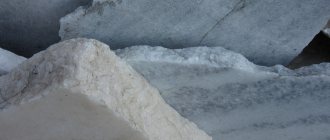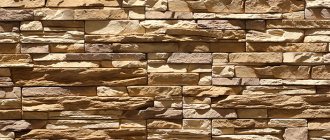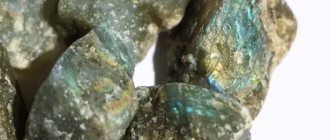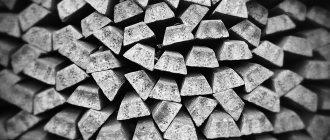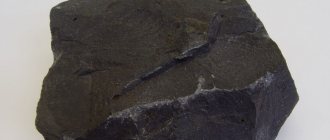Granite (translated from Latin as “grain”) is the most common rock of igneous origin. Granite rock makes up most of the earth's crust; Many varieties of granite are used in construction, glass and ceramics, architecture and art. Granite is twice as strong as marble and is inert to atmospheric phenomena - this is the reason for the huge number of buildings, structures and monuments made from this crystalline rock. The Lenin Mausoleum in Moscow, St. Isaac's Cathedral and the Alexandria Column in St. Petersburg are made of granite stone.
Stone in the history of civilization
Granite buildings have been preserved since Antiquity and Ancient Egypt.
The most famous buildings:
- obelisk in honor of the Egyptian goddess Hatshepsut;
- the national pride of Spain, El Escorial;
- Lenin's Mausoleum in Moscow.
Lenin's Mausoleum in Moscow
Amazonite granite is mentioned by Herodotus and Pliny. They connect him with the warlike tribe of Amazons who lived in the territory of ancient Scythia. Household items, jewelry, and weapons were made from stone.
St. Petersburg is built from granite: the buildings of the Academy of Arts, the Admiralty, St. Isaac's Cathedral, the Alexandrian Column. The pedestal of the city’s symbol, the Bronze Horseman, and the facing of the Neva embankment are made of stone, which was captured by the great Pushkin in the poem “The Bronze Horseman”: “The Neva is dressed in granite.”
Yellow
Yellow granite is mined in various parts of our planet, the types of Chinese deposits Sunset Gold and Tiger Skin Yellow are especially popular; the inexpensive cost of tiles of this mineral allows it to be used not only for the floors and steps of municipal buildings, but also for interior decoration of private houses. Often, when decorating the entrance area, granite balusters made of yellow granite are used; expensive rocks are used in the manufacture of countertops and stone panels.
The yellow color is quite practical for exterior decoration; traces of dust are practically invisible on it, which makes it a popular mineral when facing facades with granite .
What is granite
Granite is a common crystalline rock:
- The name is translated from Latin as “grain”, reflecting the structure of the stone.
- The rock composition is dominated by potassium feldspar (60-65%) and quartz (25-30%). The rest is divided into plagioclase and micas (biotites, muscovites). These few percent create inclusions that make granites aesthetically attractive and varied. For example, quartz and mica give the stone a sparkling shine and iridescence.
- It can be fine-, medium- or coarse-grained. The finer the grains, the stronger the rock, the more “indifferent” to natural disasters.
- Almost does not absorb water, is not afraid of frost, heat, or temperature fluctuations. Twice as strong as marble.
The stone is mined almost the old fashioned way: holes are drilled into the base of the massif and pegs are driven in. When a vertical crack appears, gunpowder shafts are drilled. The explosion breaks the block.
This is how the rock was mined in Russia under Peter I.
Brown
Like the gray types of this stone, brown granite is used both in interior and exterior decoration; coarse-grained types of rock from Indian deposits, such as Tan Brown, New Sapphire, Saphire Brown, have a very beautiful and rich texture. The combination of a rich chocolate shade interspersed with blue quartz makes the stone in demand when decorating the interiors of kitchens, bathrooms, and reception desks.
How the breed was formed
Granite is one of the main components of the earth's crust.
But exactly how the rock formed is unclear. Three hundred years ago it was believed that these were crystals fossilized on the seabed.
Today there are two versions:
- Rising to the surface, the basaltic magma captured and sintered other elements. As they cooled, they crystallized, becoming grainy granite.
- Tectonic displacement of continental plates “driven” various rocks deep into the Earth. Excessive temperature and pressure ensured crystallization (granitization).
The last two theories are studied equally. Thus, the origin of granite is considered to be volcanism or granitization.
The oldest granite samples are about 3.8 billion years old.
Usage
The use of granite as a building material has a long history: residential buildings, civil architecture, fortifications, fortifications and engineering facilities were built from stone. Solid unprocessed slabs became the base of roads, material for paving open areas, and natural boulders were used in the masonry of fortress walls, as well as the walls of residential and outbuildings.
The sarcophagus in the famous pyramid of Khafre, located on the Giza Plateau in Egypt, is made of polished granite
Nowadays granite is used for:
- Making monumental sculpture;
- Production of decorative interior parts;
- Creation of cladding of buildings, embankments, steps of stairs.
The mechanization of stone processing processes has made it possible to reveal all its beauty - polished granite surfaces look especially aesthetically pleasing and elegant, and carved elements can decorate both the exterior and interior of buildings. Granite is a rock with a grainy structure that creates the illusion of depth, and mica inclusions provide a unique play of light. Processing technologies are regularly improved, and now technologists have the opportunity to reveal all the beauty of granite. Technologies allow:
— Increase the performance properties of granite.
— Improve and add aesthetic qualities to the stone.
— Achieve greater saturation in colors;
To further reveal the properties of the stone, technologies such as polishing, artificial aging are used, and the stone is matted under pressure with water. The processing of granite “under the skin” is also interesting. Granite is processed using waterjet machines to create various patterns on the surface of the granite. The stone looks most modern and impressive when combining different textures (matte and glossy).
Physico-chemical characteristics
To a chemist, granite is an acidic rock. Acidity depends on the amount of silicon dioxide. The more it is, the lighter the color of the granite.
| Rock type | Igneous rock |
| Color | light grey, pink, red, yellow, greenish |
| Texture 2 | massive porphyry |
| Structure 2 | fine-grained medium-grained coarse-grained |
| origin of name | from granum - grain |
Color and pattern
The most popular is red or bright pink Leznikovsky granite. There are other varieties of stone that are named after their deposits, for example, the Korninsky, Sofievsky or Zhezhelevsky gray mineral.
Amazonite granite is considered to be a beautiful granite with a green or turquoise hue. Their color is due to the green feldspar contained in the rock. No less attractive are samples of amethyst color with a lilac-pink tint. The rarest type of stone is specimens with blue quartz. In some places you can find black granite. Minerals are also found in white color. Such samples look like marble. The stone can be not only snow-white, but also shades such as light green, pearlescent or pale yellow.
The pattern of granite depends on the accumulations of dark-colored inclusions. Minerals commonly found in nature have a spotted or speckled pattern. Some samples have striped-wavy patterns. Occasionally you can find granite with a pattern resembling circles or chains. A dotted pattern is formed on the rock if it contains inclusions of flat-shaped spar crystals.
Place of Birth
It is not for nothing that geologists have dubbed the rock the calling card of the planet: granite deposits surround the Earth everywhere.
Russia has fifty mines:
- Voronezh, Chelyabinsk, Sverdlovsk regions, Transbaikalia, Khabarovsk Territory, and the Urals supply white, gray, and brown stone.
- The north of the European part (Kola Peninsula, Leningrad region, Karelia) is the source of the decorative red-pink variety of granite.
The rock is extracted on almost all continents:
- Europe. Iberian Peninsula (Spain, Portugal), Bulgaria, Germany, Great Britain, Finland. In France there is an area called the “Coast of Pink Granite”.
- Italy and Ukraine give more than others. Light gray and pink stones are mined in Sardinia; the Ukrainian “Crystal Shield” (1000x200 km) runs through the entire country.
- Africa. Multi-colored rock is supplied by Ethiopia (light gray stones), Somalia (red porphyry), and Namibia (dense blue granites). The annual volume is gigantic: a total of 120 thousand cubic meters of rock.
- Both Americas. The USA, Canada, Brazil, Argentina supply gray and colored stone.
- Asia. Kazakhstan, Tajikistan, Uzbekistan supply the world with green-blue granite.
- has beautiful facing materials in gray and pink shades , but it does not waste it.
Granite layers were formed at a depth of 10-15 km. Weathering and precipitation reduced the depth to tens of meters.
The thickness of the deposits varies from small veins (up to 10 m) to multi-kilometer blocks (they are called batholiths).
The maximum depth of the rock has not been established.
Breed classification
The diversity of granite rock has created the need to organize it. The classifications are based on different parameters.
By color
Standard colors of granite are red, gray, light coffee, brown, bluish, pink, black. The rarest species is a deep blue breed from Africa.
By structure
Depending on the presence of chemical elements and minerals, the following types of stone are distinguished:
- Gneiss-like. Uniform fine grain structure plus mica flakes. Thanks to them, granites shine.
- Muscovite. Quartz in the rock is complemented by muscovite and orthoclase.
- Pegmatoid. Granites with grains of approximately the same size and varying-sized inclusions of quartz and feldspar.
- Porphyriform. The rock contains inclusions of orthoclase and quartz.
- Finnish. The stones are identified by round red-gray inclusions of orthoclase.
An interesting variety is Amazonite granite. It has a greenish-emerald to blue tint. Often the stone contains tantalum and tin. The breed is found on the Kola Peninsula, the Urals, Madagascar, and Africa (Zimbabwe).
By inclusions
Almost all granites are variegated stones with inclusions of dark shades. According to this characteristic, alaskites, leucogranites, mica, biotite, and pyroxene specimens are distinguished.
The presence of chemicals creates the lithium fluoride, alkaline, hornblende variety of the rock.
Based on the content of dark-colored minerals, the following varieties are distinguished:
- hornblende;
- biotite;
- hornblende-biotite;
- double mica;
- mica;
- hypersthene (charnockite);
- augite;
- graphite;
- diopside;
- cordierite;
- malacolithic;
- pyroxene;
- enstatite;
- epidote.
By place of production
Granite raw materials are classified according to the place of extraction. The mine almost always has its own color:
- Amazonite. Green and blue stones.
- Leznikovsky. Red, pink and their mixture.
- Korninsky, Sofievsky. White and gray stones of all shades.
Gabbro stands apart. These are black granites with a heterogeneous texture. It is a harmonious chaos of spots, waves, and inclusions of other configurations that are barely visible against a dark background. The stone is mined in different places on the planet.
By place of production
Granite deposits are distributed throughout the world. The bulk of granite ore is mined in Russia, Ukraine, Central Asia, central Europe, the USA and Africa. In Russia alone there are over 200 deposits, most of which are located in the Urals, Karelia, the Far East and Siberia.
The most famous deposits in the CIS are:
- Amazonite
. Contains rare and valuable raw materials from which green and blue granite stone is extracted. - Leznikovskoe
. It is famous for its iron and microcline content, the color of the raw materials is red, pink. - Korninskoe, Sofievskoe
. Light granite is mined in many shades.
Areas of application of granite
Granite blocks are the oldest building material. Some structures are hundreds, even thousands of years old.
This was facilitated by the properties of granite: resistance to frost, heat, temperature changes, and aggressive substances; minimal abrasion and water permeability.
Public spaces
Applications have been found for fragments of different sizes - from blocks to crumbs:
- The slabs are used to decorate the plinths of buildings (banks, offices of large companies, government agencies, private mansions).
- These same spaces are decorated from the inside with stairs, columns, sculptures, and other decorative elements made of stone.
- They lay paving stones, and curbs mark pavements, squares, and other spaces.
- Pools, fountains, and embankments are laid out with slabs.
- The crumb is in demand by landscape designers.
- Crushed stone is used to fill concrete, weigh down asphalt pavement, and embankment on railway tracks.
Granite rock is used as a floor covering for the most visited objects: metro stations, supermarkets, air terminals.
- Granite steles, obelisks, monuments are a status segment in the ritual sphere.
Areas of application of granite
Products made from granite remain in good condition for 450-500 years.
Household sphere
Granite is popular in “home” versions:
- The tabletop and window sill made from it are almost eternal. Even dishes removed from the stove or a hot iron will not damage them.
- Sinks, bathtubs, and other plumbing fixtures are durable and hygienic (does not absorb odors, household chemicals, is not afraid of boiling water, and does not rust).
- Thanks to the thermal conductivity of the stone, the water in the bathtub or sink does not cool down for a long time.
Bathroom made of granite
The products look expensive and solid.
Jewelry making, decor
Colored granite becomes beads, pendants, pendants.
Craftsmen make boxes, ashtrays, table sets, balls, and pyramids.
Granite box
The texture of the stone makes each item unique.
Physical properties
One of the most important properties of granite is its strength. The smaller the grain size in the stone, the higher this indicator. This mineral is twice as strong as marble.
The stone is divided into three groups
- Fine-grained. The grain size is less than 2 mm. Such minerals are characterized by a high degree of strength, resistance to destruction and water resistance. They are considered the most expensive and in demand due to their high quality.
- Medium grain. The grain size varies between 2−5 mm. The characteristics of this type are slightly worse than the previous one, but it is also often used in construction.
- Coarse-grained. Grains exceeding 5 mm make the material less fire resistant. At temperatures above 600 °C the stone is damaged and increases in volume.
The density of the rock is 2600 kg/m3, Mohs hardness is 5-7. Melting point - 1215−1260°C; in the presence of water and pressure it can drop to 650 °C. The average specific gravity of stone is 2700−3000 kg/m2. Granite is characterized by low water absorption and low abrasion coefficient. The stone is quite easy to process and polish , after which it retains its mirror surface for a long period. The mineral can also be carved. It can be given any shape.
The stone retains its characteristics even in the harshest environmental conditions. Granite is considered an environmentally friendly and ergonomic material. Any variety of this rock is safe for people and animals. Rock does not emit radiation. There are no restrictions on the use of granite in construction work.
Artificial granite
The development of technology has made it possible to create an analogue of natural granite rock.
The material is a composite of granite chips soldered with polyester resin.
Such granite is considered artificial with a caveat: its base is natural.
His strengths and weaknesses have been identified.
The advantages reproduce the natural properties of the stone:
- Retains heat for a long time.
- Does not crack due to temperature changes.
- Not afraid of aggressive household chemicals.
Minuses:
- The artificial stone is based on crumbs. It is firmly soldered, but cannot be compared with a natural monolith. Therefore, artificial granite requires caution when overloading.
- Polyester resin makes the material similar to plastic. This can be felt to the touch and due to its excessive shine (natural granite, even after polishing, looks noble-matte).
- Artificial stone may be scratched.
- The surface pattern is devoid of harmonious patterns inherent in natural stone.
Based on these characteristics, it is easy to distinguish natural stone from its artificial counterpart.
However, the disadvantages are compensated by the advantages:
- Artificial granite stone is devoid of microporosity, which makes it impossible for dirt or microbes to penetrate inside. Therefore, it has found application in the kitchen range.
- A larger range of colors, shades, textures, shapes is possible.
- Guaranteed zero radioactivity.
Finally, man-made material is several times cheaper than natural material.
TOP 5 popular materials for a tombstone
One year after the death of a loved one, relatives begin preparations for the installation of a headstone, which will be located in the cemetery plot for an extended period. This means that you need to choose the most durable material. But the monument must also be attractive, and not all options are suitable for this.
Monument with engraving
The best of the existing characteristics, as well as the most beautiful:
- monuments made of granite: in all respects, this material is superior to its analogues, it is attractive, which is due to its unusual structure - a large number of inclusions of different colors, in addition, granite products are durable, resistant to ultraviolet radiation, extreme temperatures, and therefore tombstones made from this material will serve for centuries ;
- marble monuments: characterized by fairly high hardness, strength, and a low Mohs scale (close to 3), making the material easy to process, but it is important to consider that it is porous, and therefore constant exposure to water is undesirable, despite its low hygroscopicity Thanks to its plasticity, marble produces highly artistic works;
- monuments made of concrete: this type is more affordable, and concrete tombstones have a significant advantage - they can be made independently, albeit in a relatively simple form, but the surface is not always smooth, like granite, marble products, the disadvantage is partially eliminated by grinding, but this may lead to unevenness - concrete is less durable;
- monuments made of glass: this material is just beginning to enter the local market, because until recently standard options were used (wood, stone, iron), even concrete is used less frequently, but glass products are attractive, they will make the tombstone original, even sophisticated ( for women), however, the material is not so fragile - high-strength tempered glass is used;
- artificial stone monuments: such materials are created from polymer components and stone chips - natural granite or marble; as a result of baking, a product of high strength, low porosity, resistant to negative external factors is obtained, and such tombstones have no external differences from products made of natural stone so significant, and they weigh less.
How to care for granite
Natural granite is not very vulnerable, but you need to take care of it:
- Countertops, window sills, floors are washed with ordinary detergent.
- To maintain the polishing of the surface, do not wipe it with abrasives and powder detergents.
- To prevent dirt, dust, and especially food debris from clogging the pores of natural stone, the surface is treated with wax polishes. The resulting film will simultaneously protect against mold, mildew, and plaque.
If repairs are to be made, it is better to cover the surface with cling film or other film in advance. But if paint does get in, it is removed with strong cleaners for stone products. They also get rid of layers of fat and soot.
Caring for artificial stone is similar. And chips and cracks are eliminated with an acrylic filling compound.
The magical powers of the stone
Even ancient magicians and sorcerers noticed the importance of granite as a protector from dark forces and unkind people. No wonder the chambers of rulers and nobility were decorated with this stone.
This property is still relevant today. It is complemented by new qualities identified by esotericists.
- This is the stone of all who teach and “gnaw the granite of science.” It will help teachers cope with the audience and convey knowledge as clearly and accurately as possible. Students can learn more deeply, present information, and remember better. Just be smarter.
Color has meaning:
- A red stone can make a person intuitive, develop intelligence and speed of reaction. At the same time, enhance creativity and find innovative solutions.
- Yellow varieties are indicated for authoritarian, ambitious people, so as not to get carried away.
- The magic of gray granite changes life for the better on all levels: work, finances, love/family, place of residence.
Granite rock of any shade cleans the room of negative energy and makes a person more sociable. This talisman is suitable for shy natures.
Selecting the type of portrait: engraving or photoceramics
All existing methods of applying identification marks, plaques and photos to a stone tombstone have the following features:
- engraving: performed directly on a stone sculpture, the depth may be different, but regardless of this parameter, the design will retain its original appearance for a long period, the manual application method is of better quality than the computer method, although it is more difficult to implement, takes longer, and increases the cost of the slab;
- photoceramics: they use blanks made of porcelain, images of people are printed on them, domestic substrates are inferior in appearance to foreign ones, but they have a drawback - loss of color over time, after which the photo will have to be changed.
